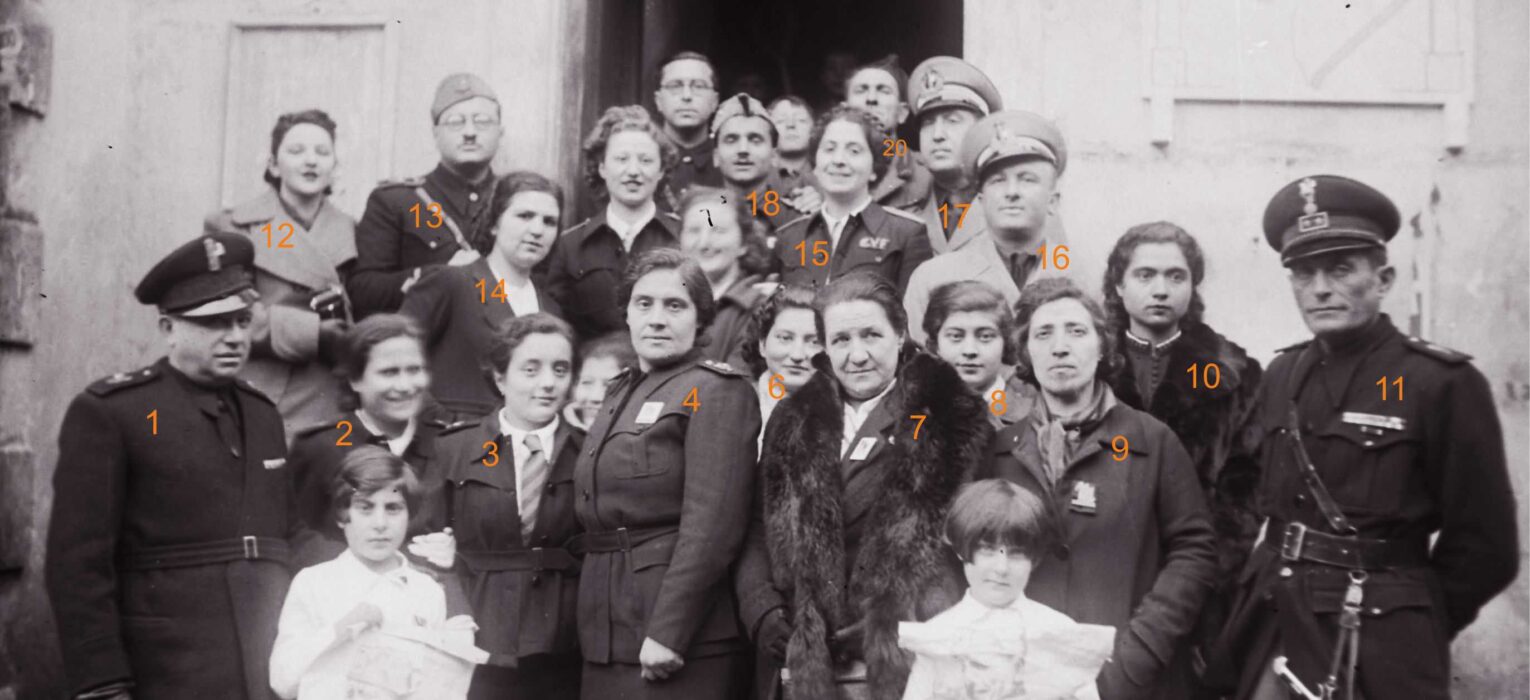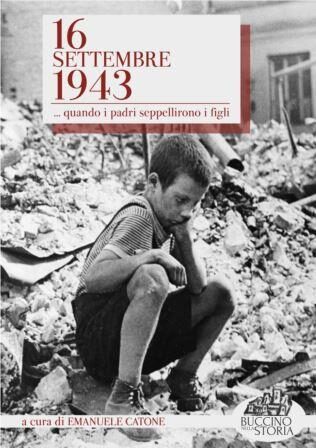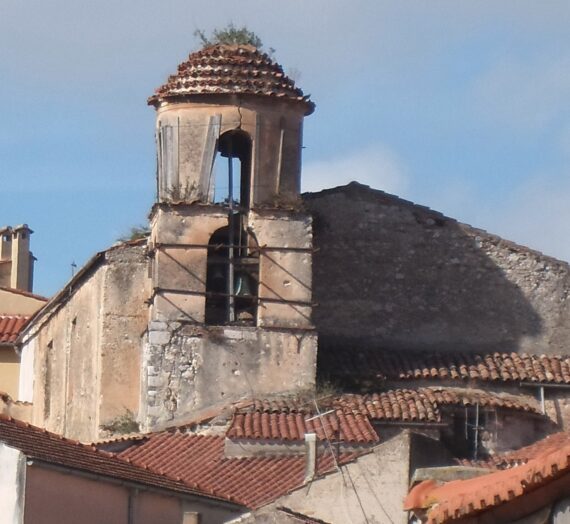We gladly propose the memories inspired by Maria Rosaria Pagnani from a photo, published on the calendar 2016 from the Banca di Credito Cooperativo di Buccino and from the archive of Giuseppe Arduino.
Swas reached by telephone, some time ago, by two friends of Buccino […] that, in a photo […] they had recognized my very young parents.
The photo was taken on the occasion of the distribution of the "Befana del Duce", established in 1928 by Augusto Turati. The 6 January or so, an envelope was distributed to less well-off schoolchildren, depicting the profile of the Duce, containing useful gifts that serve to preserve the most needy from the rawness of the season " . In the envelope that appears in the hands of the two little Italian girls in uniform, certainly, the usual gifts; four candies, six biscuits, a tangerine, some notebooks, of the nibs, some colors and perhaps a wooden or tin toy and a photograph of the Duce che, if it was not exhibited at home, it was sent back with thanks. The delivery of the envelope took place in the presence of the local authorities, of teachers and women's associations, because it was the teachers and volunteers who collected gifts from benefactors and merchants, then, subdivided, packaged and assigned.
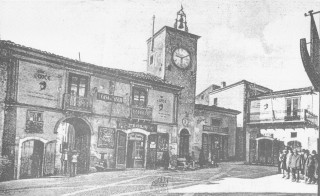
We are in January of 1937, in Piazza Amendola, the square par excellence, in front of the door that led, through a steep staircase, to the headquarters of the Fascio which in the 1950s and passed housed the Social Club, assiduously frequented by my father. To illustrate the month of November, a group of Buccinese "fascists" appears and among them my parents Ada Lettieri of twenty-two and Umberto Pagnani of thirty-seven. […] Let's move on to the photo. We still haven't been able to identify the schoolgirls, in a pleated cloth skirt and a white piquèt shirt, who are the real stars of the souvenir photo.
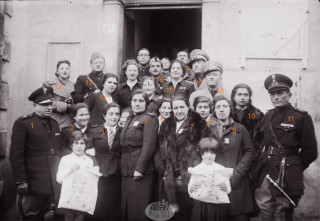
Souvenir of the fascist Befana
(CLICK PHOTO TO ENLARGE)
Starting from the bottom left here is Ernesto Grieco (1), podestà, didactic director, then, school inspector, avid reader of essays and scholar of Buccinese history, never jealous keeper of his knowledge, but prodigal in dispensing it to the young people who frequented it. He will be among the first to understand the historical importance of our country and will publish in 1959 the volume “Buccino – Ancient Volcei: history-art-tradition-culture”, which will mark the way for the publications to come.
Smiling on her left Elena Bellelli (2), Giovannina's sister who ran a bakery in the Borgo, she will marry a gentleman from Grosseto and they will have two children: Marilena (at the Maria Maddalena registry office) and Enrico who died very young struck by diphtheria. Elena, teacher will teach in the forties at the Casale.
At the time of the photo, the elementary classes were located in several neighborhoods; the first and the second in Piazza Pescara, where the Bank is today, the third was at the kindergarten of the Sisters of Compassion, the fourth in Sant’Elia in a room rented by Teresinella Fernicola Di Nunzio, the fifth together with the management was housed in the east wing of the Doge's Palace.
From the showy striped tie to refine the uniform of Donna Italiana and with a smile just sketched, because very shy and reserved, Elvira Martorelli (3) daughter of Edvige Fernicola – the Edvigiuzza woman of my childhood – and Emanuele Martorelli from Ricigliano.
She is still impetuous in her Saharan circumstance, Bianca is the first of the Cerulo sisters (4), all teachers, who have initiated some generations of Buccinesi to education. Bianca, who will keep her haughty bearing and proud gaze until old age, has never married, but he dedicated his life to schoolchildren and grandchildren.
The teacher Caterina De Rosa peeps out between Elvira and Bianca, this Tanuccia (5), sister of the more famous Gemma. Very different in character, Tanuccia did not have the great communication and determination of her sister, but she will be more reserved for her generosity. Lived in the Caivano house, elegant and stately in the ways, she too never married, she taught in elementary school until the sixties when she retired.
With wavy hair to frame the beautiful smiling face Maria Chiariello (6), fifteen year old student, she will be a teacher and will marry a Neapolitan. She is the daughter of Don Peppantonio, distinguished and elegant man in his corduroy jackets, doctor who interpreted the profession as a mission, so much so that a good reputation has accompanied him for years, even after his disappearance in 1951.
With great pomp because he could not give up a touch of elegance and wore two splendid gray foxes, Gilda Lenzi (7), the mayor's wife, the teacher Gilda. With a sweet but decisive character, she never lived in the shadow of her husband, but it has distinguished itself for its human and cultural qualities by becoming, then, the kind guest of the literary salon into which her home will be transformed. Gilda, like other ladies of the Buccino well, did not call renard (volpe) as in previous years, the two skins linked by a chain at the height of the muzzle, but silver foxes, did not prefer the pole foot, but the thousand paws, did not dress in jersey but of point fitting. Italian terms had to be adopted and disseminated, so, the manufactures of Italy against imports from France, always our rival in the field of fashion and elegance. Because rosolio was drunk in the lounges protected by heavy damask curtains and on the sofas with stiff backrests., they tasted the sweets of Bardolino, the piano was played, we leafed through magazines and also talked about fashion.
With the chubby cheeks typical of teenagers and the straight bob hair Lidia, the last, after Maria and Elvira, of the three Martorelli sisters (8), outgoing and cordial, she was the ideal company for groups of young people who gathered in the living rooms and on the terraces to enjoy the beautiful and short youth. Diplomat, he never taught, but he will be employed at the Superintendency of Studies of Salerno.
It stands out for its gruff appearance, almost threatening Rosinella Falcone (9) which at least apparently has always maintained a somewhat detached attitude, perhaps, to hide a great insecurity. It was the sister of John who, from good culture but not titled, he gave private math lessons at home, French and drawing. Don Giovanni together with don Antonio Grieco, brother priest of the Podestà, he had given birth to a kind of private school where many young Buccinesi studied for, then, obtain a master's degree in Campagna or Salerno as a private practitioner.
Immediately behind Rosinella, here is my mother Ada Lettieri (10) excessively serious for her young age, maybe a little bit’ disoriented. Ada has curly black hair with loose braids, the eyes look sad, the distant gaze does not fix the lens. On the dress with the stand-up collar she wears a teddy bear fur, years later it will end up fertilizing the olive trees of the Tempe del Mulino. Just three years have passed since she married Umberto Pagnani and crossed "rivers and mountains" to reach the Mangini house in Casale from Villa Lettieri in Capo Posillipo., where the piano plays, speak French in the mirror and embroider placemats yourself. For a few years he will return to Naples every week for a refreshing bath with non-returnable water, in Buccino there is still no running water and the one that Vincenzo Muccione carries every two days, the jailer, in a barrel to fill a temporary tank should be used sparingly. To be a mother, a present and affectionate mother, will have to wait another ten years and they will be long to pass.
To close the first row Francesco Goffredi, called Ciccio (11), elementary teacher secretary of the PNF. Man of a certain charm, alto, skinny looks good in the uniform of a centurion with a flaming sword and breeches. Married to Melina Bosco he already has three children Silvia, Peppino and Carlo, the following year the fourth Edward will be born, for friends Educcio. For me as a child, Silvia was a myth, my ideal of a woman, growing up I wanted his features, its colors, her long braid. Wasted effort growing up!
Opens the second row, always from the left, Laura Bosco (12) who is just seventeen years old, fair-skinned sun, he has a spacious forehead and a heart-shaped mouth, elegant in his wide camel cloth coat setback, lapels, holds one in his hands pouch of paint (at the time improperly called a scarabattola). Not yet graduated, he will begin his career two years later, in 1939, with a second grade at the Borgo. Casual and self-confident Laura will animate the social evenings and until the end she will be surrounded by many friends even younger than her, because it is endowed with that lively intelligence that does not lock the spirit in the cage of the years.
Next to Laura with gold-rimmed glasses, with a short thick mustache like Hitler or Charlot, Michele Verderese (13), graduated in law will never practice and will always prefer the teaching profession. Will marry not at a very young age, when it is now Don Michele, a woman from Ricigliano from whom he will have Anna Maria, Giuseppe and Luigina. It seems that the tall and robust women of Ricigliano were very much liked by the Buccinesi and so the saying I made my own for years "Femmine di Buccino and pacifiers from Caggiano" should be revised, but not correct.
To his left Gaetana Caivano, called Nella (14) who is not wearing a uniform, but a dark jacket suit made flirtatious by the zigzag cut of the lapel. Mother of our dentist Ciccio, will marry in 1950 a Saturnino D’Acunto, lawyer, leaving his home in Sant’Elia for the Borgo. In addition to being a shrewd wife and mother, she will also play a role in public offices, in fact she will be employed in the Municipality of Buccino as administrative secretary. Nella is the daughter of Donna Gemma Curzio, the piano teacher who contributed with her lessons to give the Buccinese girls the necessary education to enter society. The elegance of the Buccinese ladies at the time was the work of Sartoria Fumo which made men's and women's clothes with an impeccable and serious cut on fabrics sold by a certain Pernini, a Roman of Jewish origin who sold home and supplied many Roman fashion houses with his high quality fabrics. The most feminine and flirty dresses in evening and linen, the wedding dresses with applications of flowers and leaves were masterfully created and sewn to measure by Ida Ciaglia who also made and embroidered the layettes of the Pagnani house.
To the left of Nella, two unidentified smiling young men, even because, at least for one, the photo is somewhat faded. And here is Maria, the last of the Cerulus sisters (15), bella, smiling, regal in her crown braid hairstyle, she is also a good teacher and very maternal. I fondly remember that she was often forced to intervene when the Bevilacqua teacher energetically tested the solidity of her wand., not quite magical, about terrified schoolchildren. Maria will marry Bonaventura D'Acunto and become Raffaele's mother, Lello. It will remain beautiful and elegant, available to everyone, even in old age.
Finally, here is my father, Umberto Pagnani (16), from beauty to Spencer Tracy, a trait common to the nine males of the thirteen Pagnani da Contursi brothers. Young lawyer of the Magistrate's Court of Buccino, then cassation lawyer engaged in many famous murder trials, when misery and ignorance led to interminable feuds even for an abigeant. He chose the Volceian land as his second homeland, so much so that he wanted the Buccinese daughters. Scientific high school student “Vittorio Emanuele” of Naples, he left his studies at seventeen to enlist as a volunteer in the First World War, and was a courier on a bicycle in the Friulian land. Pre-military instructor will be recalled as lieutenant of the Bersaglieri in the second war, with his battalion he will be supporting Lake Aversano during the landing of the allies. A football fan, he will dedicate himself as president to the Buccinese of the 1950s, leading it to various victories. He will have no luck in politics.
Just behind my father, his contemporary Giuseppe Goffredi (17), don Peppe, maestro, busy, then, as secretary of the Didactic Direction of Buccino which included about eighteen municipalities in the hinterland, beyond Auletta, up to Caggiano. In 1937 he is already Gerardino's father, Corradino, Paolo and Bianca; after a few years Gigino will be born. His wife Gaetana is missing in the photo, this Tanina, other sister Cerulo, reserved and sweet in character, at the time he taught Athena Lucana, which he often reaches on the motorcycle driven by Peppe. The secretary forced for many hours between the walls of school buildings, he prefers to spend his free time outdoors and hunts for thrushes, filling his game bags with Eliceto and Faucesca birds. Many years later he will be awarded the silver medal of Knight of the Republic.
To the right of Maria Cerulo a very young Vittorino Gigante (18), with the usual fashionable mustache, reminiscent of Renato Rascel in "The coat". Just graduated, he is twenty-one years old, with a brilliant character and very studious, knows three languages: French, fluent English and German. Among his peers he is called a romantic, eternally in love with life. Will marry later, in 1950, Lina La Falce and will have three children Domenico, Mario and Patrizia. The most famous brother Marcello, grecista, papyrologist and philologist appreciated by scholars all over the world, pride of the Buccinese community, it seems he was the last secretary of the PNF in Buccino, before the fall of the regime.
Top left, bare-headed Gaetano Cupo (19), Tanino for friends, for all the master Cupo. In 1937 he is twenty-four years old he teaches in Colliano, after graduating from an institute run by Jesuits. Disappointing mother Vita who wanted him a priest, he chose the secular life and love for Iolanda da Polla whom he will marry after a few years. Theirs is a beautiful love story protected by the thirteen brothers who lovingly cared for it in the huge spaces of a magnificent castle. From the two who will live in Buccino will be born Francesco and Vito. Studying with the Jesuits was of great benefit to Tanino, in fact he will always have a great love for classical authors and for Latin in which he expressed himself with great fluency as if it were his second language. It will be a point of reference for many Buccinesi who have started their humanities.
We did not recognize the little boy who looks out between Tanino and the other gentleman with the disheveled hair. The latter, instead, is a certain Scaglione (20): we ignore the proper name, its public commitments, its private, but someone remembers that he was part of a band created in those years and he was entrusted with the bass drum, the big drum that, with a serious and professional manner, was playing in the street parties and at funerals. So the young Scaglione, who had to be a whimsical, for the sharp hits and vibrations of his bass drum he is back to being talked about.
A friend commented: These characters had to be cloned. Belonging to ancient Volceian families, whose descendants, after an inevitable diaspora, they no longer live in the old houses, they represent a Buccino engaged in the social and cultured. Emancipate, apparently united. I, that I love to find in faded photos, notes of physiognomies, I worked with pleasure on the reconstruction of an event. I liked them all and I hope you too; men and women, more and less young, elegant and modest, smiling and curmudgeons, despite the uniforms or perhaps thanks to the uniforms. They that, relying on that January of 1937 to the photographer, they could not have foreseen that about eighty years after that black and white shot would still arouse so much emotion. The beauty of photography!
MARIA ROSARIA PAGNANI
Memories of M. R. Pagnani were published under the title “When a photo tells people and facts” in “The Voice of Buccino”, 21st year, n. 1 (spring 2015). We thank the author and Angelo Imbrenda for allowing us to reproduce it.
We invite others to solicit their memory thanks to the photos made available by the project Buccino nella Storia. The pages of our blog will be happy to host the memories that you will send us.

